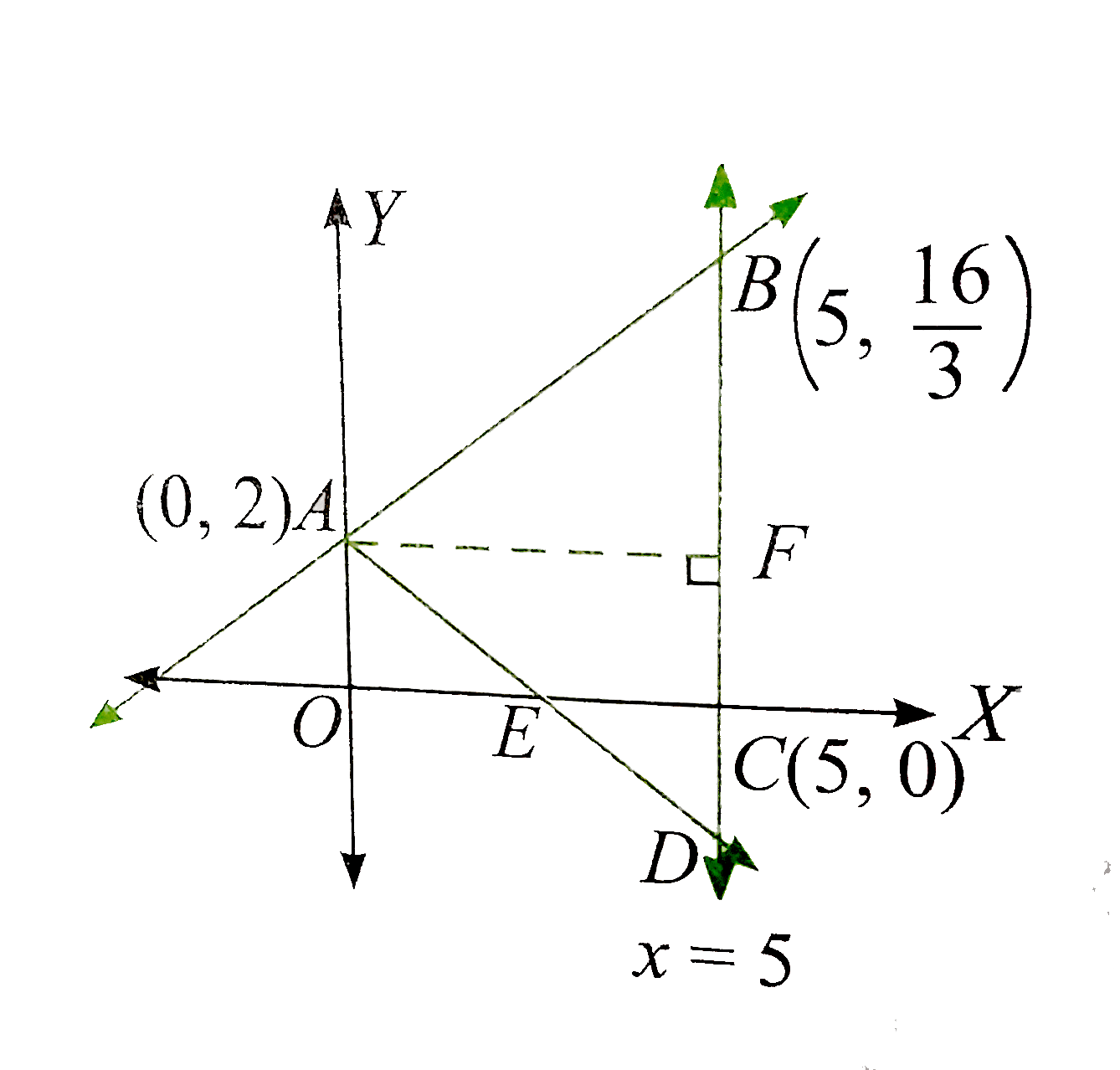A line L1=3y−2x−6=0 is rotated about its point of intersection with the y-axis in the clockwise direction to make it L2 such that the are formed by L1,L2 the x-axis, and line x=5 is 493sq.units if its point of intersection with x=5 lies below the x-axis. Find the equation of L2.Solution in Bengali
The correct Answer is:x+y=2

L1=3y−2x−6=0
The point about which the line is rotated is A = (0,2). Let the equation of L2 be y = mx +2. As L2 will be cutting line x=5 below the x-axis, we have
A≡(0,2),B≡(5,163),C≡(5,0),
D≡(5,5m+2),E≡(−2m,0)
Now, Area of AECB= Area of ΔADB−Area of ΔECD
or 493=12BD×AF−12EC×CD
=12[163−(5m+2)]×5−12×(5+2m)[−(5m+2)]
or 493=110m+126mor m=−1
Hence, the equation of L2 is x+y=2.
Topper's Solved these Questions
- STRAIGHT LINESBOOK - CENGAGE PUBLICATIONCHAPTER - STRAIGHT LINESEXERCISE - CONCEPT APPLICATION EXERCISE 2.2
4 Videos
- STRAIGHT LINESBOOK - CENGAGE PUBLICATIONCHAPTER - STRAIGHT LINESEXERCISE - CONCEPT APPLICATION EXERCISE 2.3
7 Videos
- STRAIGHT LINESBOOK - CENGAGE PUBLICATIONCHAPTER - STRAIGHT LINESEXERCISE - EXAMPLE
12 Videos
- STRAIGHT LINEBOOK - CENGAGE PUBLICATIONCHAPTER - STRAIGHT LINEEXERCISE - Multiple Correct Answers Type
8 Videos
- THEORY OF EQUATIONSBOOK - CENGAGE PUBLICATIONCHAPTER - THEORY OF EQUATIONSEXERCISE - JEE ADVANCED (Numerical Value Type )
1 Videos
Similar Questions
Two particles start from point (2, -1), one moving two units along the line x+ y = 1 and the other 5 units along the line x - 2y = 4, If the particle move towards increasing y, then their new positions are:
View SolutionFind the points on y−ais whose perpendicular distance from the line 4x−3y−12=0 is 3.
View SolutionShow that the lines 4x+y−9=0,x−2y+3=0,5x−y−6=0 make equal intercepts on any line of slope 2.
View SolutionThe point P(α,α+1) will lie inside the triangle whose vertices are A(0,3),B(−2,0) and C(6,1) if
View SolutionThe number of distinct real roots of x4−4x3+12x2+x−1=0is_____.
View SolutionA line L1≡3y−2x−6=0 is rotated about its point of intersection with the y-axis in the clockwise direction to make it L2 such that the are formed by L1,L2 the x-axis, and line x=5 is 493sq.units if its point of intersection with x=5 lies below the x-axis. Find the equation of L2.
View SolutionLet L_1 :x+y-3= 0 and L_2:7x -y +5 = 0 be two given lines. Let image of every point on L_1, with respect to a line L lies on L_2 then possible equation of L can be :
View SolutionLines L1 and L2 have slopes m and n, respectively, suppose L1 makes twice as large angle with the horizontal (mesured counter clockwise from the positive x-axis as does L2 and L1 has 4 times the slope of L2. If L1 is not horizontal, then the value of the proudct mn equals.
View SolutionLet L1 be a tangent to the parabola y2=4(x+1)andL2 be a tangent to the parabola y2=8(x+2) such that L1andL2 intersect at right angles. Then L1andL2 meet on the straight line :
View SolutionA line makes zero intersects on x axis and y axis and it is prependicular to the line 3x+4y+6=0 then its equation is
View SolutionConsider the lines given by L1:x+3y−5=0 L2:3x−ky−1=0 L3:5x+2y−12=0 Column I|Column II L1,L2,L3 are concurrent if|p. k=−9 One of L1,L2,L3 is parallel to at least one of the other two if|q. k=−65 L1,L2,L3 form a triangle if|r. k=56 L1,L2,L3 do not form a triangle if|s. k=5
View SolutionA line L1≡3y−2x−6=0 is rotated about its point of intersection with the y-axis in the clockwise direction to make it L2 such that the are formed by L1,L2 the x-axis, and line x=5 is 493sq.units if its point of intersection with x=5 lies below the x-axis. Find the equation of L2.
View Solutionθ1andθ2 are the inclination of lines L1andL2 with the x-axis. If L1andL2 pass through P(x1,y1), then the equation of one of the angle bisector of these lines is
View SolutionL1andL2 are two intersecting lines. If the image of L1 w.r.t. L2 and that of L2 w.r.t. L1 concide, then the angle between L1andL2 is
View SolutionConsider two lines L1:2x+y=4 and
L2:(2x−y=2)
Find the equation of the line passing through the intersection of L1 and L2 which makes an angle 45° with the positive direction of x−aξs.
View SolutionConsider two lines L1:2x+y=4 and
L2:(2x−y=2)
Find the equation of the line passing through the intersection of L1 and L2 which makes an angle 45° with the positive direction of x−aξs.
Find the x and y intercepts of the third line obtained.
View Solution
